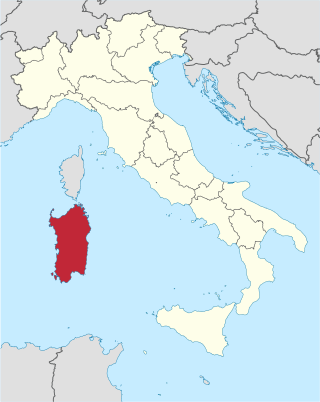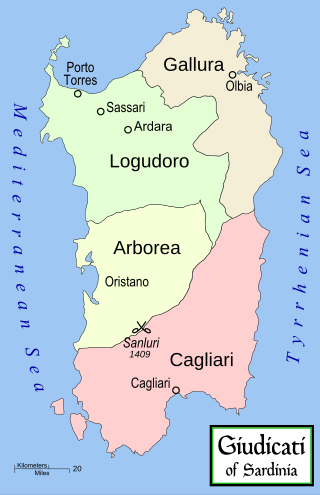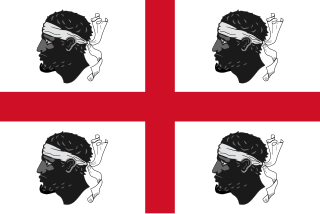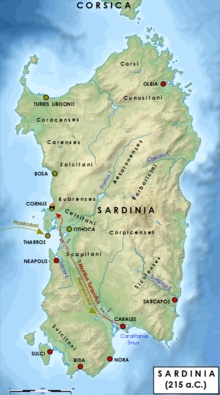
Nuoro is a city and comune (municipality) in central-eastern Sardinia, Italy, situated on the slopes of Mount Ortobene. It is the capital of the province of Nuoro. With a population of 36,347 (2011), it is the sixth-largest city in Sardinia. Its frazione (borough) of Lollove is one of I Borghi più belli d'Italia.

Sardinian or Sard is a Romance language spoken by the Sardinians on the Western Mediterranean island of Sardinia.

Sardinia is the second-largest island in the Mediterranean Sea, after Sicily, and one of the twenty regions of Italy. It is located west of the Italian Peninsula, north of Tunisia and immediately south of the French island of Corsica.

Olbia is a city and commune of 60,346 inhabitants in the Italian insular province of Sassari in northeastern Sardinia, Italy, in the historical region of Gallura. Called Olbia in the Roman age, Civita in the Middle Ages and the Terranova Pausania until the 1940s, Olbia has again been the official name of the city since the fascist period.

Cagliari is an Italian municipality and the capital and largest city of the island of Sardinia, an autonomous region of Italy. It has about 155,000 inhabitants, while its metropolitan city has about 420,000 inhabitants. According to Eurostat, the population of the functional urban area, the commuting zone of Cagliari, rises to 476,975. Cagliari is the 26th largest city in Italy and the largest city on the island of Sardinia.

Archaeological evidence of prehistoric human settlement on the island of Sardinia is present in the form of nuraghes and other prehistoric monuments, which dot the land. The recorded history of Sardinia begins with its contacts with the various people who sought to dominate western Mediterranean trade in classical antiquity: Phoenicians, Punics and Romans. Initially under the political and economic alliance with the Phoenician cities, it was partly conquered by Carthage in the late 6th century BC and then entirely by Rome after the First Punic War. The island was included for centuries in the Roman province of Sardinia and Corsica, which would be incorporated into the diocese of Italia suburbicaria in 3rd and 7th centuries.

The Judicates, in English also referred to as Sardinian Kingdoms, Sardinian Judgedoms or Judicatures, were independent states that took power in Sardinia in the Middle Ages, between the ninth and fifteenth centuries. They were sovereign states with summa potestas, each with a ruler called judge, with the powers of a king.

The Province of Sardinia and Corsica was an ancient Roman province including the islands of Sardinia and Corsica.

The Battle of Decimomannu or Caralis took place in Sardinia when a Carthaginian army sailed to the island to support a local revolt against Roman rule. The army, led by Hasdrubal the Bald, fought a similar size Roman army under the Praetor Titus Manlius Torquatus in the Fall of 215 BC somewhere between Sestu and Decimomannu, just north of Caralis. The Romans destroyed the Carthaginian army and then scattered their fleet in a sea battle south of Sardinia.

The Kingdom of Sardinia, also referred to as the Kingdom ofSardinia-Piedmont or Piedmont-Sardinia as a composite state during the Savoyard period, was a country in Southern Europe from the late 13th until the mid-19th century.

The Nuragic civilization, also known as the Nuragic culture, was a civilization or culture on the Mediterranean island of Sardinia, Italy, which lasted from the 18th century BC up to the Roman colonization in 238 BC. Others date the culture as lasting at least until the 2nd century AD and in some areas, namely the Barbagia, to the 6th century AD or possibly even to the 11th century AD.

The Sardinians, or Sards, are a Romance language-speaking ethnic group native to Sardinia, from which the western Mediterranean island and autonomous region of Italy derives its name.

The Perfect Fusion was the 1847 act of the Savoyard king Charles Albert of Sardinia which abolished the administrative differences between the mainland states and the island of Sardinia within the Kingdom of Sardinia, in a fashion similar to the Nueva Planta decrees between the Crown of Castile and the realms of the Crown of Aragon between 1707 and 1716 and the Acts of Union between Great Britain and Ireland in 1800.

The Giants of Mont'e Prama are ancient stone sculptures created by the Nuragic civilization of Sardinia, Italy. Fragmented into numerous pieces, they were discovered in March 1974 on farmland near Mont'e Prama, in the comune of Cabras, province of Oristano, in central-western Sardinia. The statues are carved in local sandstone and their height varies between 2 and 2.5 meters.
This article presents a history of Cagliari, an Italian municipality and the capital city of the island of Sardinia. The city has been continuously inhabited since at least the neo-lithic period. Due to its strategic location in the Mediterranean and natural harbor, the city was prized and highly sought after by a number of Mediterranean empires and cultures.

Vandal Sardinia covers the history of Sardinia from the end of the long Roman domination in 456, when the island was conquered by the Vandals, a Germanic population settled in Africa Proconsularis and Mauretania Caesariensis, until its reconquest by the Byzantine Roman Emperor Justinian in 534.

The Byzantine age in Sardinian history conventionally begins with the island's reconquest by Justinian I in 534. This ended the Vandal dominion of the island after about 80 years. There was still a substantial continuity with the Roman phase at this time.
The Roman-Sardinian Wars were a series of conflicts which took place in Sardinia in a span of time between the 3rd century BC and the 1st century AD. These wars involved the Romans against the major indigenous tribes which inhabited Sardinia: the Ilienses, the Balares and the Corsi of Sardinia. The struggle against Sardinians in order to maintain control of the coastal cities occupied a significant part of the efforts of the Roman Republic and the Roman Empire.

The history of Phoenician and Carthaginian Sardinia deals with two different historical periods between the 9th century BC and the 3rd century BC concerning the peaceful arrival on the island of the first Phoenician merchants and their integration into the Nuragic civilization by bringing new knowledge and technologies, and the subsequent Carthaginian presence aimed at exploiting mineral resources of the Iglesiente and controlling the fertile plains of the Campidano.

The Kingdom of Sardinia was a feudal state in Southern Europe created in the early 14th century and a possession of the Crown of Aragon first and then of the Spanish Empire until 1708, then of the Habsburgs until 1717, and then of the Spanish Empire again until 1720.















